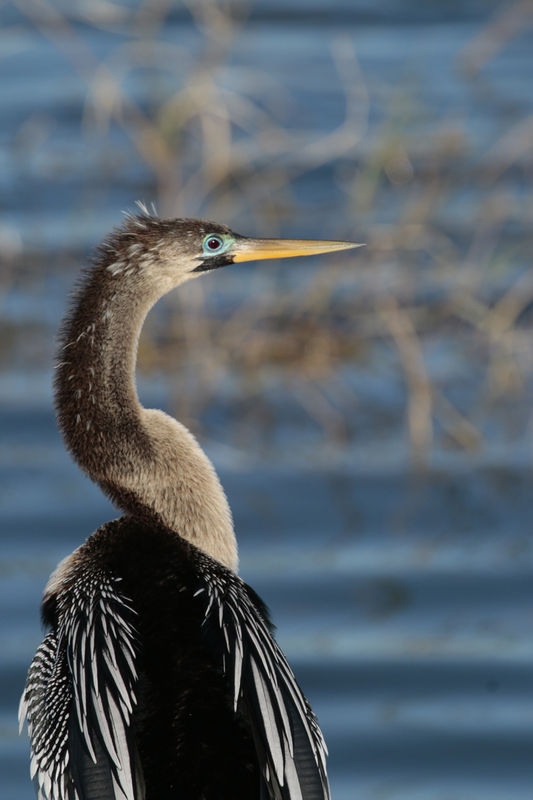Green-eyed Anhinga
Feb 15, 2016 07:55:04 #
My bird books are not the detailed books of serious birders - lots of photos but not tons of detail.
So - why do some anhingas have green eyes and others do not? White feathers and others do not? Male versus female? Mating plumage? This one is always at the same spot next to the road and is happy to pose any time I walk by (at the Viera Wetlands in Brevard County Florida).
So - why do some anhingas have green eyes and others do not? White feathers and others do not? Male versus female? Mating plumage? This one is always at the same spot next to the road and is happy to pose any time I walk by (at the Viera Wetlands in Brevard County Florida).

Feb 15, 2016 07:59:30 #
Feb 15, 2016 08:14:23 #
sb wrote:
My bird books are not the detailed books of serious birders - lots of photos but not tons of detail.
So - why do some anhingas have green eyes and others do not? White feathers and others do not? Male versus female? Mating plumage? This one is always at the same spot next to the road and is happy to pose any time I walk by (at the Viera Wetlands in Brevard County Florida).
So - why do some anhingas have green eyes and others do not? White feathers and others do not? Male versus female? Mating plumage? This one is always at the same spot next to the road and is happy to pose any time I walk by (at the Viera Wetlands in Brevard County Florida).
beautiful great shot
Check out Film Photography section of our forum.
Feb 15, 2016 08:53:17 #
According to my Nat Geo Field Guide:
"During breeding season, male acquires pale, wispy plumes on upper neck; bill and bare facial skin becomes brightly colored." Audubon Handbook mentions the same.
Very nice shot!
"During breeding season, male acquires pale, wispy plumes on upper neck; bill and bare facial skin becomes brightly colored." Audubon Handbook mentions the same.
Very nice shot!
Feb 15, 2016 09:58:09 #
Cwilson341 wrote:
According to my Nat Geo Field Guide:
"During breeding season, male acquires pale, wispy plumes on upper neck; bill and bare facial skin becomes brightly colored." Audubon Handbook mentions the same.
Very nice shot!
"During breeding season, male acquires pale, wispy plumes on upper neck; bill and bare facial skin becomes brightly colored." Audubon Handbook mentions the same.
Very nice shot!
Thanks, Carol!
Feb 15, 2016 09:58:41 #
Feb 15, 2016 09:59:21 #
Cwilson341 wrote:
According to my Nat Geo Field Guide:
"During breeding season, male acquires pale, wispy plumes on upper neck; bill and bare facial skin becomes brightly colored." Audubon Handbook mentions the same.
Very nice shot!
"During breeding season, male acquires pale, wispy plumes on upper neck; bill and bare facial skin becomes brightly colored." Audubon Handbook mentions the same.
Very nice shot!
And he IS a most handsome fellow! What female could resist?
Check out Traditional Street and Architectural Photography section of our forum.
Feb 15, 2016 10:00:45 #
sb wrote:
And he IS a most handsome fellow! What female could resist?
:) :thumbup:
Feb 15, 2016 14:01:16 #
Feb 15, 2016 17:37:48 #
Excellent capture, Steve and each one makes me wish that we were there!
Feb 16, 2016 06:56:47 #
sb wrote:
And he IS a most handsome fellow! What female could resist?
Actually this is a super shot of a female. The males are black all over, females have the brown neck and throat.
Check out Underwater Photography Forum section of our forum.
Feb 16, 2016 09:05:50 #
firtree wrote:
Actually this is a super shot of a female. The males are black all over, females have the brown neck and throat.
OK - thanks. I am going to have to look this up - or at least order a more detailed field guide!
Feb 16, 2016 14:25:11 #
sb wrote:
OK - thanks. I am going to have to look this up - or at least order a more detailed field guide!
Steve, I think I understand better now. What I quoted earlier is what is in both of my hard copy guides. However, they also say the male is darker, mostly black and the female more brown. I googled Anhinga and found a site that mentioned that the female also develops the enhanced eye color during mating season. It did not mention the head feathers but the feathers on this particular bird are not nearly as prominent as some I have seen so I am guessing the female also develops that characteristic but to a lesser extent. The guides are great but they don't cover every detail. Also, the color of a bird may appear different in different light.
This shot is an exceptional capture no matter what!!
Feb 16, 2016 14:54:09 #
Feb 17, 2016 14:18:26 #
Cwilson341 wrote:
Steve, I think I understand better now. What I qu... (show quote)
Yes - the more I read the more unclear it is to me! I am still not sure. I am paying more attention to the anhingas and some are indeed very dark all over. Only a few seem to have the blue/green skin around the eye. Waiting for a new bird guide that I ordered - probably won't clear things up.
If you want to reply, then register here. Registration is free and your account is created instantly, so you can post right away.
Check out Professional and Advanced Portraiture section of our forum.






